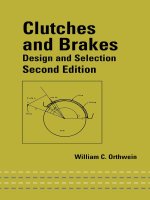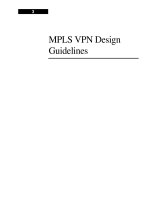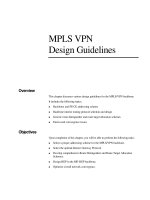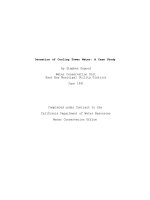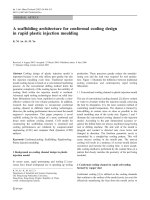Cooling tower design guidelines
Bạn đang xem bản rút gọn của tài liệu. Xem và tải ngay bản đầy đủ của tài liệu tại đây (353.99 KB, 27 trang )
2200 Cooling Tower Design Guidelines
Abstract
This section discusses key cooling tower design parameters, electrical facility installation, environment/safety/fire protection considerations, and forebay design.
Contents
Page
2210 Key Parameters
2200-2
2211 Heat Load (Duty)
2212 Circulating Water Rate (GPM)
2213 Wet Bulb Temperatures
2214 Optimizing Cooling Tower Costs
2215 Makeup Water
2216 Blowdown and Cycles of Concentration
2220 Electrical Installations
2200-10
2221 Area Classification
2222 Materials
2223 Installation
2230 Environmental/Safety/Fire Protection Considerations
2200-11
2231 Effluent Quality
2232 Air Quality
2233 Safety
2234 Fire Protection
2240 Cooling Tower Forebay Design
2200-16
2241 General Information
2242 Forebay Design
2243 Hydraulic Model Testing
2244 Standard Drawings
2245 References
Chevron Corporation
2200-1
December 1989
2200 Cooling Tower Design Guidelines
Heat Exchanger and Cooling Tower Manual
2210 Key Parameters
This section discusses the key design parameters that must be considered when
purchasing or rating a cooling tower. The actual rating procedure is in Section 2300.
2211 Heat Load (Duty)
The tower duty is calculated using the following equation:
Duty Q MMBH = m⋅Cp ⋅ (Th - Tc)
(Eq. 2200-1)
where:
m = Circulation water flow in pounds per hour.
Cp = Specific heat in Btu/lb⋅°F
Th = Hot water to the tower, °F
Tc = Cold water from the cooling tower basin, °F
Converting pounds per hour to gallons per minute and using a Cp of 1,
Q (MMBH) = 500 ⋅ GPM ⋅ (Th - Tc)
The 500 comes from converting Item 1 from GPM to lb/hr: (8.33 lb/gal ⋅ 60 min/hr)
= 500.
The calculated heat load is usually increased by a factor of 10 to 20% to obtain the
design heat load.
2212 Circulating Water Rate (GPM)
Conversely, if we have the duty and we want to find the circulating water rate
assuming a temperature range:
Q
GPM = -------------------------------500 ( T h – T c )
(Eq. 2200-2)
The circulation rate and temperatures are developed by looking at:
1.
All the heat exchanger duties in the cooling tower network.
2.
The cooling water flow rates and temperatures to satisfy the design conditions
for the heat exchangers.
By summing all the duties of the heat exchangers in the network and taking the
weighted averages of all the inlet and outlet temperatures of the circulating water in
GPM, Th and Tc can be determined. For each circulating water rate there is a
unique hot and cold water temperature combination.
December 1989
2200-2
Chevron Corporation
Heat Exchanger and Cooling Tower Manual
2200 Cooling Tower Design Guidelines
2213 Wet Bulb Temperatures
Determining the design wet bulb temperature is an important decision, as investment costs are involved. Figure 2200-1 lists the ambient design wet bulb temperatures at a number of our operating centers.
Fig. 2200-1 Design Wet Bulb Temperatures at Several Company Locations
Design Wet Bulb °F
Location
Anchorage, Alaska
59
Bahamas, Freeport
79
Cedar Bayou (Bayport, Texas)
82
El Paso, Texas
70
El Segundo, California
70
Hawaii
73
Kaybob
61
Marietta, Ohio
77
Mt. Belvieu (Bayport, Texas)
82
Orange, Texas
80
Pascagoula, Mississippi
79
Philadelphia, Pennsylvania
76
Port Arthur, Texas
82
Richmond, California
65
Salt Lake, Utah
65
St. James, Louisiana
80
St. John, N. B.
65
Vancouver (Burnaby)
68
Considerations for Design Wet Bulb
Chevron Corporation
1.
Cooling towers should be oriented so that the longitudinal axis is aligned with
(parallel to) the prevailing wind. If the plot plan will not accommodate this
orientation, the wet bulb temperature shown in Figure 2200-1 may need to be
increased by 1°F.
2.
Cooling tower performance can be measurably affected by external influences
on the wet bulb temperature of the air entering the tower. Examples of this are
localized heat sources situated upwind, drift from adjacent cooling towers,
recirculation of exit air caused by large structures adjacent to the tower, etc.
For more information on recirculation, request a copy of CTI Bulletins PFM110 and PFM-�������������������������������������������������������������������������������������������������������������������������������������������������������������������������������������������������������������������������������������������������������������������������������������������������������������������������������������������������������������������������������������������������������������������������������������������������������������������������������������������������������������������������������������������������������������������������������������������������������������������������������������������������������������������������������������������������������������������������������������������������������������������������������������������������������������������������������������������������������������������������������������������������������������������������������������������������������������������������������������������������������������������������������������������������������������������������������������������������������������������������������������������������������������������������������������������������������������������������������������������������������������������������������������������������������������������������������������������������������������������������������������������������������������������������������������������������������������������������������������������������������������������������������������������������������������������������������������������������������������������������������������������������������������������������������������������������������������������������������������������������������������������������������������������������������������������������������������������������������������������������������������������������������������������������������������������������������������������������������������������������������������������������������������������������������������������������������������������������������������������������������������������������������������������������������������������������������������������������������������������������������������������������������������������������������������������������������������������������������������������������������������������������������������������������������������������������������������������������������������������������������������������������������������������������������������������������������������������������������������������������������������������������������������������������������������������������������������������������������������������������������������������������������������������������������������������������������������������������������������������������������������������������������������������������������������������������������������������������������������������������������������������������������������������������������������������������������������������������������������������������������������������������������������������������������������������������������������������������������������������������������������������������������������������������������������������������������������������������������������������������������������������������������������������������������������������������������������������������������������������������������������������������������������������������������������������������������������������������������������������������������������������������������������������������������������������������������������������������������������������������������������������������������������������������������������������������������������������������������������������������������������������������������������������������������������������������������������������������������������������������������������������������������������������������������������������������������������������������������������������������������������������������������������������������������������������������������������������������������������������������������������������������������������������������������������������������������������������������������������������������������������������������������������������������������������������������������������������������������������������������������������������������������������������������������������������������������������������������������������������������������������������������������������������������������������������������������������������������������������������������������������������������������������������������������������������������������������������������������������������������������������������������������������������������������������������������������������������������������������������������������������������������������������������������������������������������������������������������������������������������������������������������������������������������������������������������������������������������������������������������������������������������������������������������������������������������������������������������������������������������������������������������������������������������������������������������������������������������������������������������������������������������������������������������������������������������������������������������������������������������������������������������������������������������������������������������������������������������������������������������������������������������������������������������������������������������������������������������������������������������������������������������������������������������������������������������������������������������������������������������������������������������������������������������������������������������������������������������������������������������������������������������������������������������������������������������������������������������������������������������������������������������������������������������������������������������������������������������������������������������������������������������������������������������������������������������������������������������������������������������������������������������������������������������������������������������������������������������������������������������������������������������������������������������������������������������������������������������������������������������������������������������������������������������������������������������������������������������������������������������������������������������������������������������������������������������������������������������������������������������������������������������������������������������������������������������������������������������������������������������������������������������������������������������������������������������������������������������������������������������������������������������������������������������������������������������������������������������������������������������������������������������������������������������������������������������������������������������������������������������������������������������������������������������������������������������������������������������������������������������������������������������������������������������������������������������������������������������������������������������������������������������������������������������������������������������������������������������������������������������������������������������������������������������������������������������������������������������������������������������������������������������������������������������������������������������������������������������������������������������������������������������������������������������������������������������������������������������������������������������������������������������������������������������������������������������������������������������������������������������������������������������������������������������������������������������������������������������������������������������������������������������������������������������������������������������������������������������������������������������������������������������������������������������������������������������������������������������������������������������������������������������������������������������������������������������������������������������������������������������������������������������������������������������������������������������������������������������������������������������������������������������������������������������������������������������������������������������������������������������������������������������������������������������������������������������������������������������������������������������������������������������������������������������������������������������������������������������������������������������������������������������������������������������������������������������������������������������������������������������������������������������������������������������������������������������������������������������������������������������������������������������������������������������������������������������������������������������������������������������������������������������������������������������������������������������������������������������������������������������������������������������������������������������������������������������������������������������������������������������������������������������������������������������������������������������������������������������������������������������������������������������������������������������������������������������������������������������������������������������������������������������������������������������������������������������������������������������������������������������������������������������������������������������������������������������������������������������������������������������������������������������������������������������������������������������������������������������������������������������������������������������������������������������������������������������������������������������������������������������������������������������������������������������������������������������������������������������������������������������������������������������������������������������������������������������������������������������������������������������������������������������������������������������������������������������������������������������������������������������������������������������������������������������������������������������������������������������������������������������������������������������������������������������������������������������������������������������������������������������������������������������������������������������������������������������������������������������������������������������������������������������������������������������������������������������������������������������������������������������������������������������������������������������������������������������������������������������������������������������������������������������������������������������������������������������������������������������������������������������������������������������������������������������������������������������������������������������������������������������������������������������������������������������������������������������������������������������������������������������������������������������������������������������������������������������������������������������������������������������������������������������������������������������������������������������������������������������������������������������������������������������������������������������������������������������������������������������������������������������������������������������������������������������������������������������������������������������������������������������������������������������������������������������������������������������������������������������������������������������������������������������������������������������������������������������������������������������������������������������������������������������������������������������������������������������������������������������������������������������������������������������������������������������������������������������������������������������������������������������������������������������������������������������������������������������������������������������������������������������������������������������������������������������������������������������������������������������������������������������������������������������������������������������������������������������������������������������������������������������������������������������������������������������������������������������������������������������������������������������������������������������������������������������������������������������������������������������������������������������������������������������������������������������������������������������������������������������������������������������������������������������������������������������������������������������������������������������������������������������������������������������������������������������������������������������������������������������������������������������������������������������������������������������������������������������������������������������������������������������������������������������������������������������������������������������������������������������������������������������������������������������������������������������������������������������������������������������������������������������������������������������������������������������������������������������������������������������������������������������������������������������������������������������������������������������������������������������������������������������������������������������������������������������������������������������������������������������������������������������������������������������������������������������������������������������������������������������������������������������������������������������������������������������������������������������������������������������������������������������������������������������������������������������������������������������������������������������������������������������������������������������������������������������������������������������������������������������������������������������������������������������������������������������������������������������������������������������������������������������������������������������������������������������������������������������������������������������������������������������������������������������������������������������������������������������������������������������������������������������������������������������������������������������������������������������������������������������������������������������������������������������������������������������������������������������������������������������������������������������������������������������������������������������������������������������������������������������������������������������������������������������������������������������������������������������������������������������������������������������������������������������������������������������������������������������������������������������������������������������������������������������������������������������������������������������������������������������������������������������������������������������������������������������������������������������������������������������������������������������������������������������������������������������������������������������������������������������������������������������������������������������������������������������������������������������������������������������������������������������������������������������������������������������������������������������������������������������������������������������������������������������������������������������������������������������������������������������������������������������������������������������������������������������������������������������������������������������������������������������������������������������������������������������������������������������������������������������������������������������������������������������������������������������������������������������������������������������������������������������������������������������������������������������������������������������������������������������������������������������������������������������������������������������������������������������������������������������������������������������������������������������������������������������������������������������������������������������������������������������������������������������������������������������������������������������������������������������������������������������������������������������������������������������������������������������������������������������������������������������������������������������������������������������������������������������������������������������������������������������������������������������������������������������������������������������������������������������������������������������������������������������������������������������������������������������������������������������������������������������������������������������������������������������������������������������������������������������������������������������������������������������������������������������������������������������������������������������������������������������������������������������������������������������������������������������������������������������������������������������������������������������������������������������������������������������������������������������������������������������������������������������������������������������������������������������������������������������������������������������������������������������������������������������������������������������������������������������������������������������������������������������������������������������������������������������������������������������������������������������������������������������������������������������������������������������������������������������������������������������������������������������������������������������������������������������������������������������������������������������������������������������������������������������������������������������������������������������������������������������������������������������������������������������������������������������������������������������������������������������������������������������������������������������������������������������������������������������������������������������������������������������������������������������������������������������������������������������������������������������������������������������������������������������������������������������������������������������������������������������������������������������������������������������������������������������������������������������������������������������������������������������������������������������������������������������������������������������������������������������������������������������������������������������������������������������������������������������������������������������������������������������������������������������������������������������������������������������������������������������������������������������������������������������������������������������������������������������������������������������������������������������������������������������������������������������������������������������������������������������������������������������������������������������������������������������������������������������������������������������������������������������������������������������������������������������������������������������������������������������������������������������������������������������������������������������������������������������������������������������������������������������������������������������������������������������������������������������������������������������������������������������������������������������������������������������������������������������������������������������������������������������������������������������������������������������������������������������������������������������������������������������������������������������������������������������������������������������������������������������������������������������������������������������������������������������������������������������������������������������������������������������������������������������������������������������������������������������������������������������������������������������������������������������������������������������������������������������������������������������������������������������������������������������������������������������������������������������������������������������������������������������������������������������������������������������������������������������������������������������������������������������������������������������������������������������������������������������������������������������������������������������������������������������������������������������������������������������������������������������������������������������������������������������������������������������������������������������������������������������������������������������������������������������������������������������������������������������������������������������������������������������������������������������������������������������������������������������������������������������������������������������������������������������������������������������������������������������������������������������������������������������������������������������������������������������������������������������������������������������������������������������������������������������������������������������������������������������������������������������������������������������������������������������������������������������������������������������������������������������������������������������������������������������������������������������������������������������������������������������������������������������������������������������������������������������������������������������������������������������������������������������������������������������������������������������������������������������������������������������������������������������������������������������������������������������������������������������������������������������������������������������������������������������������������������������������������������������������������������������������������������������������������������������������������������������������������������������������������������������������������������������������������������������������������������������������������������������������������������������������������������������������������������������������������������������������������������������������������������������������������������������������������������������������������������������������������������������������������������������������������������������������������������������������������������������������������������������������������������������������������������������������������������������������������������������������������������������������������������������������������������������������������������������������������������������������������������������������������������������������������������������������������������������������������������������������������������������������������������������������������������������������������������������������������������������������������������������������������������������������������������������������������������������������������������������������������������������������������������������������������������������������������������������������������������������������������������������������������������������������������������������������������������������������������������������������������������������������������������������������������������������������������������������������������������������������������������������������������������������������������������������������������������������������������������������������������������������������������������������������������������������������������������������������������������������������������������������������������������������������������������������������������������������������������������������������������������������������������������������������������������������������������������������������������������������������������������������������������������������������������������������������������������������������������������������������������������������������������������������������������������������������������������������������������������������������������������������������������������������������������������������������������������������������������������������������������������������������������������������������������������������������������������������������������������������������������������������������������������������������������������������������������������������������������������������������������������������������������������������������������������������������������������������������������������������������������������������������������������������������������������������������������������������������������������������������������������������������������������������������������������������������������������������������������������������������������������������������������������������������������������������������������������������������������������������������������������������������������������������������������������������������������������������������������������������������������������������������������������������������������������������������������������������������������������������������������������������������������������������������������������������������������������������������������������������������������������������������������������������������������������������������������������������������������������������������������������������������������������������������������������������������������������������������������������������������������������������������������������������������������������������������������������������������������������������������������������������������������������������������������������������������������������������������������������������������������������������������������������������������������������������������������������������������������������������������������������������������������������������������������������������������������������������������������������������������������������������������������������������������������������������������������������������������������������������������������������������������������������������������������������������������������������������������������������������������������������������������������������������������������������������������������������������������������������������������������������������������������������������������������������������������������������������������������������������������������������������������������������������������������������������������������������������������������������������������������������������������������������������������������������������������������������������������������������������������������������������������������������������������������������������������������������������������������������������������������������������������������������������������������������������������������������������������������������������������������������������������������������������������������������������������������������������������������������������������������������������������������������������������������������������������������������������������������������������������������������������������������������������������������������������������������������������������������������������������������������������������������������������������������������������������������������������������������������������������������������������������������������������������������������������������������������������������������������������������������������������������������������������������������������������������������������������������������������������������������������������������������������������������������������������������������������������������������������������������������������������������������������������������������������������������������������������������������������������������������������������������������������������������������������������������������������������������������������������������������������������������������������������������������������������������������������������������������������������������������������������������������������������������������������������������������������������������������������������������������������������������������������������������������������������������������������������������������������������������������������������������������������������������������������������������������������������������������������������������������������������������������������������������������������������������������������������������������������������������������������������������������������������������������������������������������������������������������������������������������������������������������������������������������������������������������������������������������������������������������������������������������������������������������������������������������������������������������������������������������������������������������������������������������������������������������������������������������������������������������������������������������������������������������������������������������������������������������������������������������������������������������������������������������������������������������������������������������������������������������������������������������������������������������������������������������������������������������������������������������������������������������������������������������������������������������������������������������������������������������������������������������������������������������������������������������������������������������������������������������������������������������������������������������������������������������������������������������������������������������������������������������������������������������������������������������������������������������������������������������������������������������������������������������������������������������������������������������������������������������������������������������������������������������������������������������������������������������������������������������������������������������������������������������������������������������������������������������������������������������������������������������������������������������������������������������������������������������������������������������������������������������������������������������������������������������������������������������������������������������������������������������������������������������������������������������������������������������������������������������������������������������������������������������������������������������������������������������������������������������������������������������������������������������������������������������������������������������������������������������������������������������������������������������������������������������������������������������������������������������������������������������������������������������������������������������������������������������������������������������������������������������������������������������������������������������������������������������������������������������������������������������������������������� of the intake mouth should not be smaller than the diameter of
the suction piping.
c.
A gate valve should be installed in the suction piping between the forebay
wall and expansion joints. The pump may then be “disconnected” from the
forebay during inspection and maintenance.
Guidelines for Vertical Pumps Only
The following general guidelines are applicable to forebays with vertical pumps at
capacities exceeding 3000 GPM; these standards should be used in conjunction
with the guidelines above for both horizontal and vertical pumps.
Chevron Corporation
1.
Submergence for net positive suction head and minimal vortexing should be
according to pump manufacturer’s recommendations. Typically, minimum
submergence is two times the suction bell diameter.
2.
Necessary changes in floor elevation should occur at least three suction bell
diameters upstream of the pump column(s).
3.
In multiple pump installations where pumps must be placed in line of flow,
turning vanes under each suction bell may deflect the flow upward and directly
into the pump. Vanes may be unnecessary if both the longitudinal distance
between intakes and the ratio of forebay to pump size are quite large.
2200-19
December 1989
2200 Cooling Tower Design Guidelines
4.
Heat Exchanger and Cooling Tower Manual
In multiple pump installations where flow distribution is skewed and pumps do
not operate simultaneously, flow splitters may redirect the flow to the suction
bells. Flow splitter lengths should be greater than four bell diameters.
Recommended Dimensions: 3000 to 300,000 GPM Capacity
The recommended forebay dimensions and layouts as shown in Figures 2200-6
through 2200-8 are applicable to facilities with either horizontal or vertical pumps
in the 3000 to 300,000 GPM capacity range (see also Standard Drawing GBQ99594). All dimensions are based on the rated capacity of each pump at design
head.
Dimension C is the distance between the bottom lip of suction bell and the forebay
floor. It is an average value subject to changes suggested by the pump manufacturer.
Dimension B is the recommended maximum distance between the centerline of the
suction bell and the forebay back wall. If actual Dimension B exceeds the
suggested length for structural or mechanical reasons, a “false” back wall may be
installed.
Dimension S is the recommended minimum center-to-center distance between
suction bells. In single pump installations, it is the minimum forebay width.
Dimension H is the suggested “normal low water level.” It is not the minimum
submergence required to prevent vortexing; submergence is normally defined as the
quantity H minus C.
Dimension Y is the minimum distance between the bell centerline and the first
upstream obstruction inside the forebay. For most bell designs, Dimension Y is
approximately three bell diameters.
Dimension A is the minimum overall forebay length when the average flow
velocity in the forebay is less than 2.0 feet per second.
Recommended Dimensions: Pumps Larger Than 300,000 GPM
The recommended forebay dimensions and layouts as shown in Figures 2200-9
through 2200-11 are applicable to facilities with either horizontal or vertical pumps
in the 300,000 GPM-plus capacity range. Dimensions are based on the intake or
suction bell diameter; unless noted otherwise, dimension symbols are identical to
those previously noted.
Dimension D is the diameter of the pump intake or suction bell.
Dimension X is the recommended distance between the edge of the bell and the
back forebay wall.
Dimension d is the diameter of the suction line or pump column.
December 1989
2200-20
Chevron Corporation
Heat Exchanger and Cooling Tower Manual
2200 Cooling Tower Design Guidelines
Fig. 2200-6 Sump Dimensions vs. Flow, 3000 to 300,000 GPM Capacity (Courtesy of the Hydraulic Institute)
Fig. 2200-7 Elevation of Basic Forebay Design, 3000 to 300,000 GPM Capacity (Courtesy of the Hydraulic Institute)
Chevron Corporation
2200-21
December 1989
2200 Cooling Tower Design Guidelines
Heat Exchanger and Cooling Tower Manual
Fig. 2200-8 Plan of Basic Forebay Design, 3000 to 300,000 GPM Capacity (Courtesy of the Hydraulic Institute)
2243 Hydraulic Model Testing
Because the hydraulic problems associated with forebay design are functions of
many variables, analysis of expected flow conditions is difficult. Unfortunately,
outside circumstances often force the designer to deviate from the design standards—and expected resulting flow conditions—described herein. On these occasions, scaled hydraulic model testing may be the best method to analyze the
preliminary design.
In-situ simulation, while another possible alternative, is usually impractical. A
scaled model is more efficient because the system geometry can be quickly and
easily modified. The forebay size may be adjusted, various screen blockages
modeled, and instrumentation located in all areas of interest to measure momentum,
velocity distribution, and velocity changes at obstructions. Model forebay walls are
usually constructed of Plexiglas so that modelers and engineers may observe flow
patterns throughout the model.
The model should encompass all forebay components likely to influence the flow
entering the pump(s). Model boundaries should be located in areas where flow
pattern control has minimal boundary effects on the system. Models normally use
either equal Froude numbers or velocities; no significant scale effects occur in 1:2
and 1:4 models.
When conducted by an independent laboratory or the pump manufacturer, hydraulic
models are relatively inexpensive, reliable tools to analyze the hydraulic performance of a preliminary design. Modifications suggested by models may also result
in substantial savings in later forebay construction, operation, and maintenance.
Since 1986, hydraulic models have been used to analyze the Richmond Refinery’s
December 1989
2200-22
Chevron Corporation
Heat Exchanger and Cooling Tower Manual
2200 Cooling Tower Design Guidelines
Fig. 2200-9 Elevation of Basic Forebay Designs, Pumps Larger than 300,000 GPM (From Hydraulic Design of Pump
Sumps and Intakes by Prosser. 1980 by the Construction Industry Research & Information Assn.,
London. Used with permission.)
Chevron Corporation
2200-23
December 1989
2200 Cooling Tower Design Guidelines
Heat Exchanger and Cooling Tower Manual
Fig. 2200-10 Plan of Basic Forebay Design, in Plane of Uniform Flow Approaching the Pumps, 300,000 GPM - Plus
Capacity (From Hydraulic Design of Pump Sumps and Intakes by Prosser. 1980 by the Construction
Industry Research & Information Assn., London. Used with permission.)
Fig. 2200-11 Plan of Basic Forebay Design, 300,000 GPM - Plus Capacity (From Hydraulic Design of Pump Sumps and
Intakes by Prosser. 1980 by the Construction Industry Research & Information Assn., London. Used
with permission.)
December 1989
2200-24
Chevron Corporation
Heat Exchanger and Cooling Tower Manual
2200 Cooling Tower Design Guidelines
flow splitter box of the 1A and 2A Separators, pump station of the Deep Water
Outfall, and No. 13 Separator.
In addition to developing possible structural modifications to improve flow conditions in preliminary forebay design, models may also be used to correct conditions
in existing forebays. These improvements, the usual basic recommendations of a
model, are:
Increase the “normal low water level”. Usually, to simultaneously increase the
“normal low water level” and accommodate the desired operating forebay volume,
the forebay must be deepened. This change may increase excavation and engineering costs.
Install antivortex devices. Devices such as cones, splitters, grids, and extension
plates may prevent or reduce vortexing in the forebay. The devices shown in
Figures 2200-12 and 2200-13 should also be selected in consultation with the pump
manufacturer.
Reshape the approach flow. Modifications may occur in the existing piping that
supplies the forebay and/or the inlet to the forebay.
2244 Standard Drawings
The following standard drawing is included in the Standard Drawings and Forms
section of this manual.
•
GB-Q99594 Piping and Screen Details, Suction Pit for Cooling Tower Basin.
2245 References
Chevron Corporation
1.
Hydraulic Institute Standards for Centrifugal, Rotary & Reciprocating Pumps,
14th Edition, Hydraulic Institute, 1983.
2.
Nystrom, James B., et al., “Modeling Flow Characteristics of Reactor Sumps,”
Journal of the Energy Division, ASCE, Vol. 108, No. EY3, November 1982.
3.
Padmanabhan, M., and G. E. Hecker, “Scale Effects on Pump Sump Models,”
Journal of Hydraulic Engineering, ASCE, Vol. 110, No. 11, November 1984.
4.
Prosser, M. J., The Hydraulic Design of Pump Sumps and Intakes, British
Hydromechanics Research Association/Construction Industry Research and
Information Association, 1980.
5.
Sweeney, Charles E., et al., “Pump Sump Design Experience: Summary,”
Journal of the Hydraulics Division, ASCE, Vol. 108, No. HY3, March 1982.
2200-25
December 1989
2200 Cooling Tower Design Guidelines
Heat Exchanger and Cooling Tower Manual
Fig. 2200-12 Modifications to Intake Design to Reduce Vortices (From Hydraulic Design of Pump Sumps and Intakes
by Prosser. 1980 by the Construction Industry Research & Information Assn., London. Used with
permission.)
December 1989
2200-26
Chevron Corporation
Heat Exchanger and Cooling Tower Manual
2200 Cooling Tower Design Guidelines
Fig. 2200-13 Other Modifications to Intake Design to Reduce Vortices (From Hydraulic Design of Pump Sumps and
Intakes by Prosser. 1980 by the Construction Industry Research & Information Assn., London. Used
with permission.)
Chevron Corporation
2200-27
December 1989

